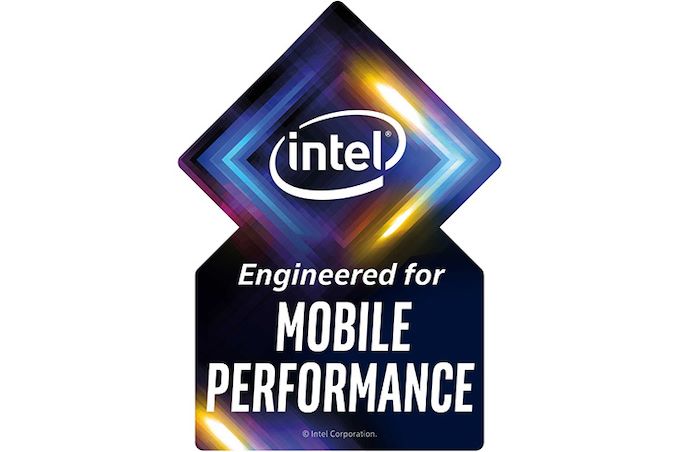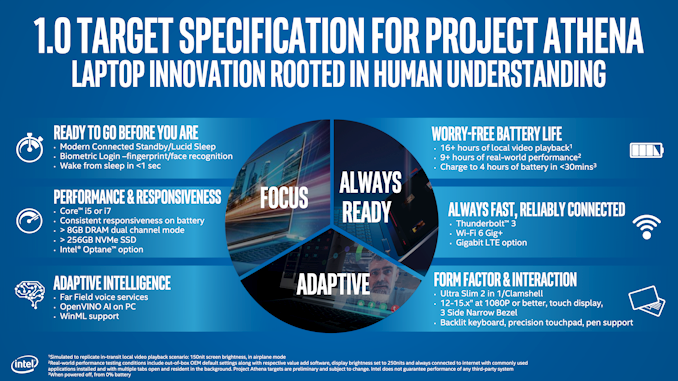Intel Unveils ‘Engineered for Mobile Performance’ Badge for Project Athena Program
by Anton Shilov on August 12, 2019 12:00 PM EST- Posted in
- Notebooks
- Intel
- Laptops
- Ice Lake
- Project Athena
- 10th Gen Core

With the release of the first Ice Lake-U laptops, Intel has announced that there will be a badge/visual identifier for laptops that comply with Intel's Project Athena standard. The ‘Engineered for Mobile Performance’ label will be used for online listings, product pages, on in-store display systems, on packaging, and for demonstrations. Do note, however, that there won't be any ‘Engineered for Mobile Performance’ badges on actual notebooks. Apparently, neither Intel nor PC makers want to put badges on the chassis of premium computers (this itself typically being treated as a premium feature).
Stylized like a medal, Intel’s ‘Engineered for Mobile Performance’ label indicates that a particular notebook meets Intel’s key experience indicators (KEI) for Athena laptops, which stipulate requirements for performance, features, and battery life, among other things. As previously announced, Intel is doing Athena verification itself, so any product carrying the label means that it has been verified by Intel’s tests and conducted by Intel’s specialists.
With the Athena specifications set to be revised every year, for this first year’s ‘Engineered for Mobile Performance’ notebooks that comply with the Project Athena v1.0 specification, Intel wants the following.
| Intel Project Athena v. 1.0 Requirements | ||
| Feature | Requirement | |
| Form-Factor | An ultra-thin clamshell or convertible notebook, or a 2-in-1 hybrid PC. | |
| Display | Touch-enabled 12 – 15-inch display with narrow bezels. At least a Full-HD resolution. Stylus support |
|
| Internal Hardware | Intel’s 10th Gen Core i5 or Core i7 processor with Intel Dynamic Tuning Technology. At least 8 GB of dual-channel DRAM. At least a 256 GB NVMe SSD with or without Optane H10 caching SSD. |
|
| Responsiveness | Consistent responsiveness both on battery and on power outlet. | |
| Instant Action | Connected Standby/Lucid Sleep support. Wake up from sleep in less than a second. Wake up to Internet browsing time should not exceed two seconds. |
|
| Wireless Connectivity | Wi-Fi 6 and optional Gigabit LTE. | |
| Wired Connectivity | Thunderbolt 3. | |
| Battery Life | At least 9 hours of mixed-workload battery life at 250 nits display brightness. At least 16 hours of local video playback. Fast charge support. |
|
| Intelligence | Far Field microphone with voice services. Hardware-accelerated OpenVINO AI and WinML support (which requires Ice Lake). |
|
| Interaction | Backlit keyboard, precision touchpad, touch display, stylus. | |
While the PC notebook market is (and will remain) widely varied in features, performance, and prices, Intel is ultimately aiming to tighten up the high-end portion of the market by giving its OEM/ODM partners goals, and matching incentives to reach them. PC hardware in general has been a continual race to the bottom – OEMs are always looking for an edge in costs/price – so in this respect Athena is an effort to entice OEMs to use higher-quality, more expensive (and frequently all-Intel) parts for better performance and greater energy efficiency. Intel is no stranger to this strategy, having employed something similar for both their Centrino and Ultrabook programs, so they are once again turning to it to shape the direction of high-end laptops going into 2020, as well as fending off a push from Arm-based laptops.
The first laptop to meet Intel’s Project Athena program requirements is Dell’s XPS 13 2-in-1 model 7390 that became available on August 8. Shortly, Acer’s Swift 5, HP’s Envy 13 Wood Series, and Lenovo’s Yoga S940 will also make their debut.
Related Reading:
- Intel's Project Athena: Defining The Next Generation Of Premium Laptops
- Intel Unveils 10th Gen Core Ice Lake-U & Ice Lake-Y Mobile CPUs: 10nm Sunny Cove Later This Year
- Examining Intel's Ice Lake Processors: Taking a Bite of the Sunny Cove Microarchitecture
Source: Intel











49 Comments
View All Comments
nandnandnand - Monday, August 12, 2019 - link
"At least 8 GB of dual-channel DRAM.At least a 265 GB NVMe SSD with or without Optane H10 caching SSD."
I see a "more than" sign, not "more than or equal to".
Also 256 GB, not 265 GB.
"Do note, however, that there won't be any ‘Engineered for Mobile Performance’ badges on actual notebooks. Apparently, neither Intel nor PC makers want to put badges on chassis of premium computers (this itself typically being treated as a premium feature)."
Wait for AMD Zen 2 mobile APUs. Don't reward Intel.
Teckk - Monday, August 12, 2019 - link
When are the mobile Zen 2s out btw, Q4 this year?Also, good set of requirements for a laptop and mostly will be at least 4 digits entry price (the linked XPS was $999). Interesting that MacBook Pros won't meet this, although I guess Apple couldn't care less.
willis936 - Monday, August 12, 2019 - link
Or could they? 🤔JanW1 - Tuesday, August 13, 2019 - link
Apple does not need to meet that $999 price. This price tag is for the 4-GB, 2-core, 256-GB SSD version of the XPS 13. This does not meet the Project Athena specifications. Oh and the SSD is soldered down for good measure, to make sure you need to bin this thing as soon as your hard drive becomes too small.willis936 - Monday, August 12, 2019 - link
Or could they? 🤔Teckk - Monday, August 12, 2019 - link
If they could, they would, so if they couldn't they wouldn't :D :Pajp_anton - Monday, August 12, 2019 - link
No.If they could, they would, so if they wouldn't, they couldn't.
DanNeely - Monday, August 12, 2019 - link
There's no real reason Apple couldn't make a touchscreen Macbook. But it would require backing down from their long standing position that touch screens are useless on laptops. It'd also probably cut into ipad/iphone sales to mobile developers who're personally android users but need to support both.Virtual IOS devices are fast enough you don't for performance reasons; but trying to use a touchscreen UI with a mouse/touchpad sucks badly enough you really do. (Virtual android devices are slow enough performance wise that you really need real hardware to test on even if you have a touchscreen laptop.)
Teckk - Monday, August 12, 2019 - link
Their long standing reasoning on touch screen laptops is pretty much real enough for them to not have it so far :)Anyway I personally don't miss the touch screen on a laptop. Used to shifting between a Windows laptop and a MB Pro, not a major deficiency for me personally at least.
PeachNCream - Monday, August 12, 2019 - link
I have to agree with Apple on that one. I own a laptop with a touchscreen and it's pretty pointless. I've poked it a few times when I first got it and since have just used either an external mouse or the touchpad. The only thing the touchscreen does is force the laptop to have a glossy screen with has lots of glare and makes the computer heavier for no good reason.